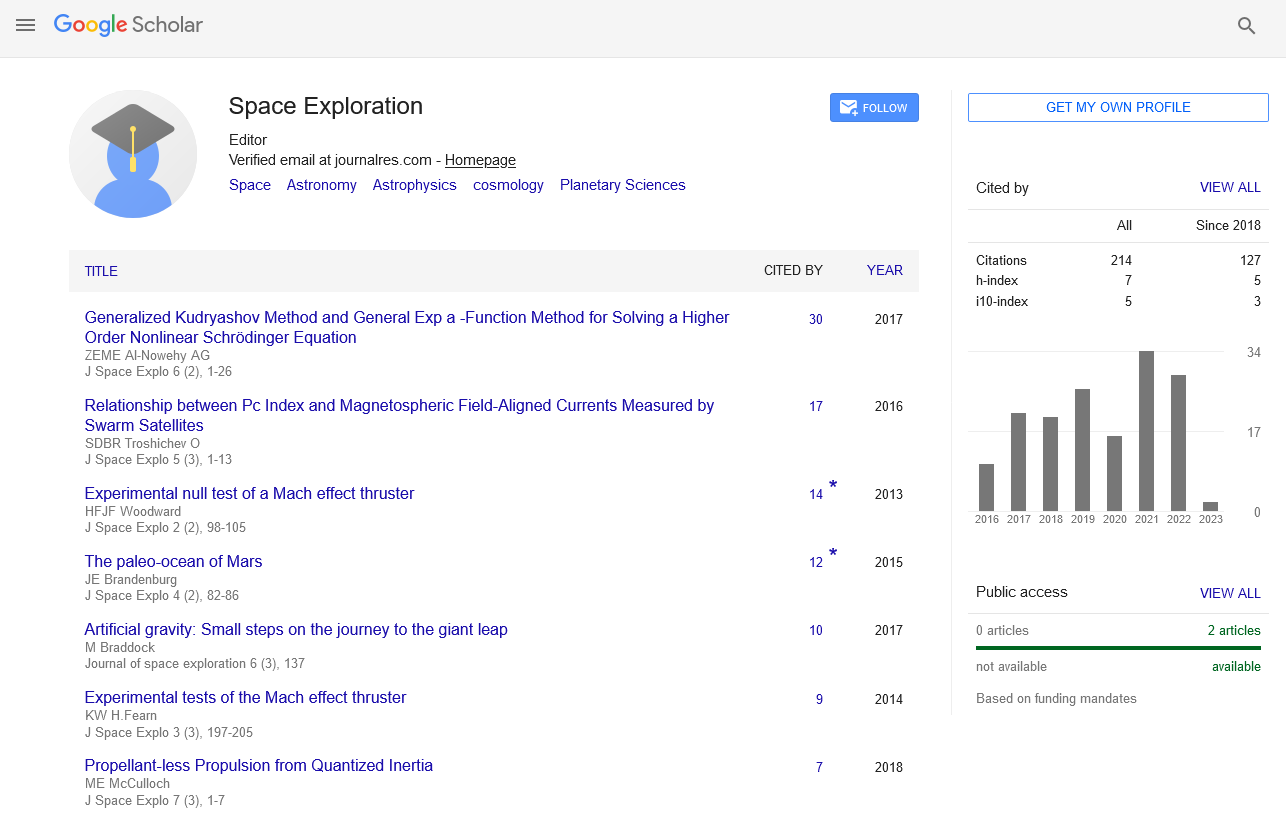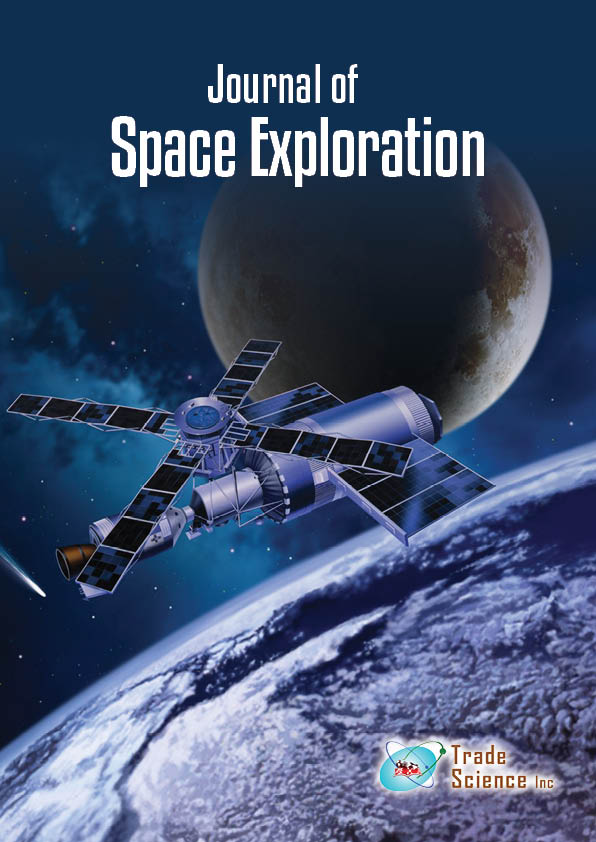Perspective
, Volume: 13( 12)The Evolution of Human Spaceflight: From Apollo to Mars Missions
Received date: Dec-8-2024, Manuscript No tsse-25-159413; Editor assigned: Dec-10-2024, Pre-QC No. tsse-25-159413(PQ); Reviewed: Dec - 12-2024, QC No tsse-25-159413(Q); Revised: Dec-14-2024, Manuscript No. tsse-25-159413(R); Published: Dec-30-2024, DOI.10.37532/2320- 6756.2024.13(12).382
Citation: Green S. The Evolution of Human Spaceflight: From Apollo to Mars Missions. 2024;13(12).382
Abstract
Human spaceflight has evolved significantly since the historic Apollo missions that landed astronauts on the Moon. From the early days of space exploration in the 1960s to the cutting-edge Mars missions of the future, advancements in technology, knowledge, and international collaboration have shaped the trajectory of human space exploration. The Apollo program set the stage for future missions by demonstrating the feasibility of human space travel beyond Earthâ??s atmosphere. Today, the focus is shifting toward more ambitious goals, particularly the exploration and eventual colonization of Mars. This commentary explores the evolution of human spaceflight, from the Apollo missions to the new frontiers of Mars exploration, considering the technological, operational, and human challenges that have accompanied this journeyIntroduction
Human spaceflight has been one of the most remarkable achievements in human history, with a rich legacy stretching from the early space race to the upcoming Mars missions. The success of the Apollo program in the 1960s and 1970s, which led to the first human landing on the Moon, was a pivotal moment in the history of space exploration. Since then, technological advancements, international partnerships, and an expanding understanding of human physiology in space have paved the way for the next giant leap—human missions to Mars. The progression from the Apollo missions to Mars exploration has been marked by not only advancements in spacecraft technology and mission design but also a deeper understanding of the complexities involved in longduration space travel. While the Apollo program demonstrated the feasibility of sending astronauts to the Moon and returning them safely, future missions, such as those aimed at Mars, present entirely new challenges in terms of distance, duration, life support systems, and radiation exposure. This commentary examines how the evolution of human spaceflight has prepared humanity for the next step in space exploration—landing on Mars and beyond.
Technological advancements for mars exploration
While the Apollo program demonstrated that humans could venture beyond Earth's orbit, sending astronauts to Mars is a much more complex endeavor. The distance from Earth to Mars is significantly greater than that to the Moon, and a round-trip mission could take several years. As such, technological developments and advancements in several key areas will be necessary to make human missions to Mars a reality.
One of the most significant challenges is developing spacecraft capable of carrying humans on long-duration missions. Unlike the relatively short Apollo missions, a Mars mission will require spacecraft with life support systems capable of sustaining astronauts for months, if not years. These systems must provide adequate food, water, oxygen, and waste management, all while mitigating the dangers of space radiation. To address this, current projects like NASA's Orion spacecraft and SpaceX’s Starship are designed with the goal of transporting humans on deep-space missions, including Mars.
Additionally, advancements in propulsion technologies, such as nuclear thermal propulsion, are being explored to reduce travel time to Mars and make the journey more feasible. These innovations are critical to overcoming the extended duration of space travel and the resulting impacts on the human body and mind.
Human challenges and exploration beyond mars
Human spaceflight to Mars also presents numerous physiological and psychological challenges. The prolonged exposure to microgravity, the risk of radiation exposure, and the effects of confinement during long-duration missions will require extensive preparation and countermeasures. For instance, astronauts on Mars missions will need to maintain physical health through exercise regimens to combat muscle atrophy and bone density loss due to microgravity. Furthermore, radiation exposure from the Sun and cosmic rays presents a significant risk, and developing protective shielding is a priority for space agencies.
Conclusion
The evolution of human spaceflight—from the Apollo missions to the impending Mars missions—represents a significant leap in humanity's ability to explore and inhabit space. The technological innovations and lessons learned from previous missions have laid the foundation for future endeavors, while the challenges ahead are more complex than ever before. As we look toward Mars and beyond, it is clear that the success of these missions will depend on continued advancements in technology, a deep understanding of human health in space, and international collaboration. From Mars rovers and satellite maintenance to asteroid exploration and infrastructure development on other celestial bodies, robots are enhancing our ability to explore space and laying the foundation for future missions. As technology advances, robotics will continue to evolve, incorporating more sophisticated AI, machine learning, and collaborative systems to carry out increasingly complex tasks autonomously. Looking ahead, robotics will be essential for human missions to the Moon, Mars, and beyond, supporting astronauts and enabling exploration of deeper space regions. As we push further into the cosmos, the synergy between humans and robots will be key to achieving the long-term goals of space exploration, from resource utilization to the establishment of sustainable colonies in space. The future of space exploration is inevitably intertwined with the continued development and application of robotics, providing a glimpse into the vast possibilities of exploring and inhabiting other worlds. For instance, astronauts on Mars missions will need to maintain physical health through exercise regimens to combat muscle atrophy and bone density loss due to microgravity. Furthermore, radiation exposure from the Sun and cosmic rays presents a significant risk, and developing protective shielding is a priority for space agencies.

